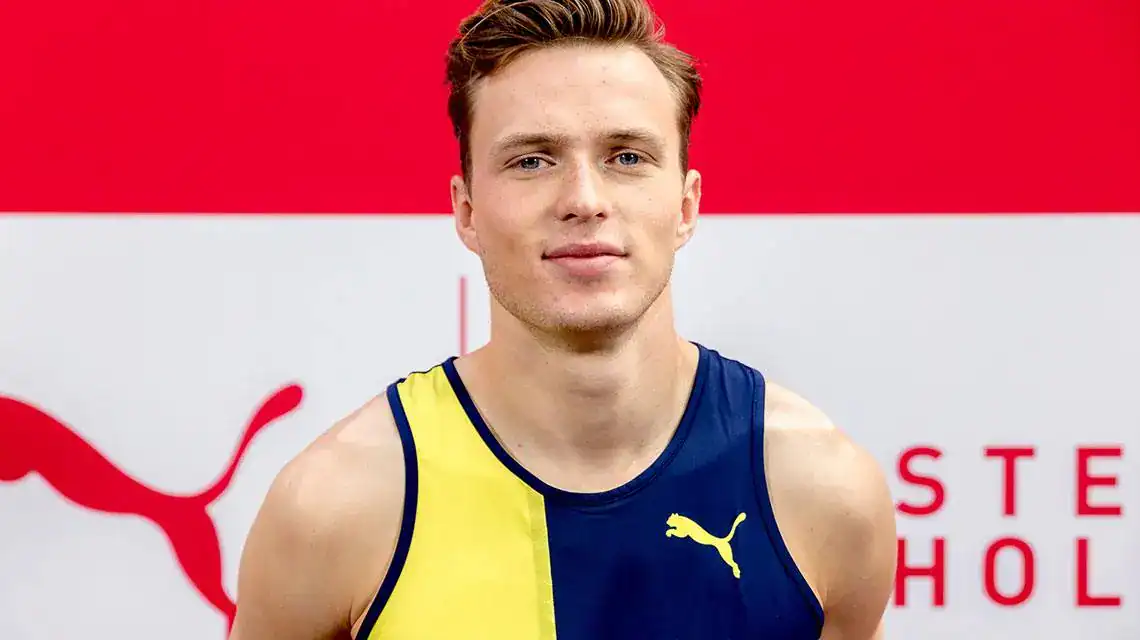Karsten Warholm at a Glance
- Net Worth: $5 Million
- Profession: Track & Field Athlete (Hurdler)
- Nationality: Norwegian
- Birthdate: February 28, 1996
- Birthplace: Ulsteinvik, Norway
- Height: 1.87 m (6 ft 2 in)
Table of Contents
What is Karsten Warholm’s Net Worth?
Karsten Warholm has a net worth of $5 million. The Norwegian hurdler, widely regarded as one of the greatest track and field athletes of all time, has built his fortune primarily through lucrative endorsement deals rather than competition prize money. While track athletics typically offers lower financial rewards compared to team sports like football or basketball, Warholm’s status as a global icon and World Record holder allows him to command premium sponsorship fees that dwarf his on-track earnings.
His financial portfolio is anchored by long-term partnerships with major global brands, most notably Puma and Red Bull. These corporations utilize Warholm’s image not just in Norway, but in international marketing campaigns, significantly boosting his annual income. Beyond endorsements, Warholm earns consistent revenue through appearance fees at Diamond League meets, championship bonuses from World Athletics, and performance incentives for breaking records.
Red Bull
Warholm joins a very exclusive tier of athletes sponsored by Red Bull. The energy drink giant is known for backing athletes who redefine the limits of human performance, making Warholm—who shattered the 400m hurdles world record—an ideal fit. This partnership goes beyond simple logo placement; it includes high-budget marketing activations, such as the widely publicized 100-meter exhibition race against Mondo Duplantis in Zurich. These “special events” generate substantial media value and appearance fees outside the traditional track and field season.
Diamond League & Prize Money
While endorsements form the bulk of his wealth, Warholm is also a high earner on the track. He commands one of the highest appearance fees in the sport, meaning meet organizers pay him a guaranteed sum simply to show up and race, regardless of the result. When combined with prize money—typically $10,000 for a Diamond League win and $50,000 to $70,000 for World Championship gold medals—his race-day earnings provide a steady stream of liquid income. Furthermore, Warholm has triggered multiple six-figure bonuses from sponsors for his world-record-breaking performances.
Early Life
Born in the small town of Ulsteinvik, Norway, Karsten Warholm grew up with a natural aptitude for multiple sports. His athletic foundation was built not on hurdles, but on the decathlon, a discipline that requires proficiency in ten different track and field events. This multi-sport background gave him the strength and versatility that later defined his hurdling technique.
He trained under the guidance of local coaches before forming a legendary partnership with Leif Olav Alnes. Their relationship is often credited as the catalyst for his success, blending Alnes’s old-school discipline with Warholm’s explosive talent. Warholm eventually shifted his focus exclusively to the 400-meter hurdles, a decision that transformed him from a talented junior decathlete into a global superstar.
Career
Karsten Warholm’s career is defined by his aggressive running style and his complete rewriting of the history books. His breakthrough on the global stage occurred at the 2017 World Championships in London, where he won gold in the 400m hurdles, surprising many with his fearless “go out hard” strategy. This victory ended the dominance of American hurdlers and signaled the start of a new era in the event. He successfully defended his title at the 2019 World Championships in Doha, proving his longevity at the top of the sport.
The pinnacle of Warholm’s career came during the Tokyo Olympics (held in 2021). In what is widely considered one of the greatest races in Olympic history, Warholm obliterated his own world record, clocking a time of 45.94 seconds. This performance shattered the psychological 46-second barrier, a feat previously thought impossible. He defeated his rival Rai Benjamin in a high-speed duel that elevated the profile of the 400m hurdles to the marquee event of the Games.
Following his Olympic triumph, Warholm continued to dominate the Diamond League circuit. In 2023, he secured his third World Championship gold in Budapest, further cementing his legacy. Although he took silver at the 2024 Paris Olympics, finishing behind Benjamin, Warholm remains the fastest man in history and a central figure in the sport’s most exciting rivalry. His ability to consistently run sub-47-second races has kept him as the highest-ranked hurdler in the world for the majority of the last decade.
Real Estate
Warholm resides in Oslo, Norway, where he owns a high-value apartment. Consistent with his relatively grounded public persona, he has not splurged on a massive portfolio of international properties. Instead, he invested in a comfortable home base close to his training facilities at the Bislett Stadium. The property market in Oslo is among the most expensive in Scandinavia, and his residence reflects his status as one of the country’s highest-earning athletes.
Personal Life
Karsten Warholm is in a long-term relationship with Oda Djupvik. The couple has been together for over a decade, having met well before Warholm became a global household name. Djupvik works in finance and holds a degree from the BI Norwegian Business School, currently working as a portfolio manager. Her background adds a “power couple” dynamic to their relationship, with Warholm managing the athletics and Djupvik navigating the corporate financial sector.
Djupvik is also a cancer survivor, having overcome the disease at the age of 18. Warholm frequently credits her resilience as an inspiration for his own work ethic. The couple maintains a relatively low profile compared to other sports stars, preferring to keep their private life out of the tabloids. Outside of training, Warholm is known for his avid interest in building LEGO sets, a hobby he uses to decompress and maintain focus between high-pressure competitions.






